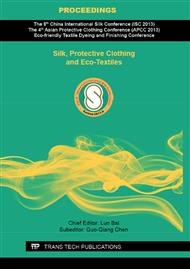p.617
p.623
p.630
p.634
p.639
p.643
p.649
p.653
p.657
Numerical Simulation the Airflow Field in the Flame Retardant Cloth Ducts
Abstract:
Fiber air dispersion system (FADS) is a new flexible ventilation terminal in ventilated areas. It can be used in both air transmission and air diffusion. The cloth duct made of flame retardant polyester is critical. The conditioned air can be dispersed to environment by not only micro pores in the fabric but also slot and orifice on the fabric. The micro-pores in the fabric exist in the yarns and fibers. The laser can be used to cut the slot and orifice on the fabric. They can be designed based on the application. In this paper, air dispersion models and basic characteristics of fiber air dispersion system were introduced. Based on computational fluid mechanics theory, the flame retardant cloth ducts (FRCD) is regard as an isotropic porous media. The air dispersion physical model for micro porous that sends the air to the environment was established. And the Carman-kozeny equation was used in this model, which was described the airflow field in the FRCD. Finally the airflow field in the FRCD was numerically simulated with the FLUENT software based on the finite element method. The air flow resistance of the fabrics was calculated by the Darcy model.
Info:
Periodical:
Pages:
643-648
Citation:
Online since:
September 2013
Authors:
Price:
Сopyright:
© 2013 Trans Tech Publications Ltd. All Rights Reserved
Share:
Citation:


